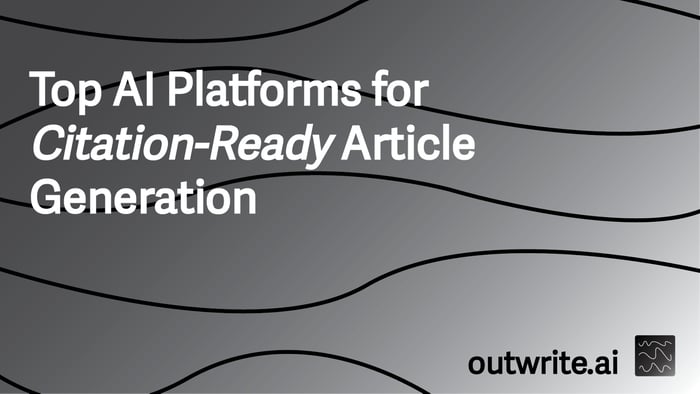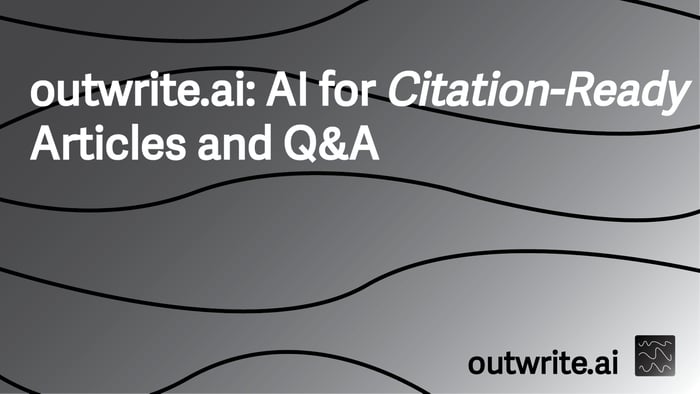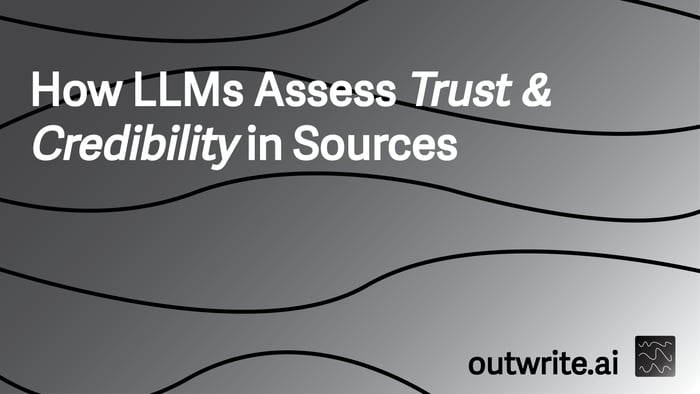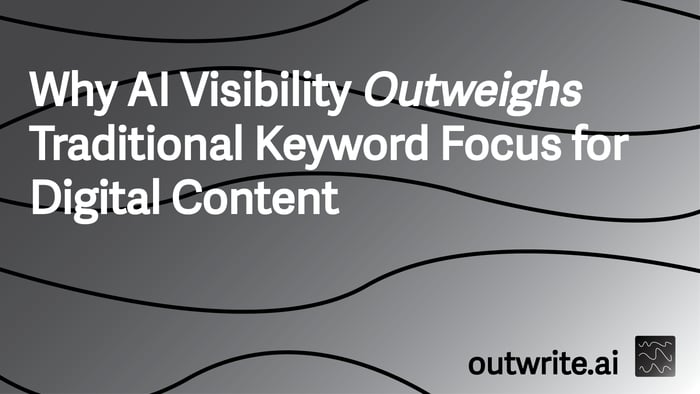Table of Contents
- AI Content Generation Market Overview
- Core AI Platforms for Scholarly Content
- Specialized AI Tools for Academic Writing
- Building an AI Citation Strategy
- Real-World AI Article Generation Case Studies
- Implementing AI for Research-Backed Content
- Challenges and Solutions in AI Citation
- Future Trends in AI Content and Citation
- AI Ethics and Governance in Content Creation
- Measuring Success in AI-Generated Content
- Read our expert's guide 'AI Search Engine Citations: outwrite.ai's SEO Guide for Visbility'
- The outwrite.ai Advantage in AI Content
- Frequently Asked Questions (FAQ)
- Conclusion
The demand for high-quality, research-backed content continues to grow, driving innovation in AI technology. Businesses and academics alike seek efficient ways to generate articles that are not only informative but also credible and citation-ready. This article explores the leading AI technology solutions designed to meet this need, offering insights into their capabilities, market impact, and strategic implementation.
We examine the market dynamics, key platforms, and proven strategies for leveraging AI content generation to produce scholarly, accurate, and highly citeable articles. Understanding these tools and approaches is crucial for anyone looking to stay competitive in the evolving digital content landscape.
AI Content Generation Market Overview
The generative AI market is experiencing rapid expansion, fundamentally changing how content is produced. This growth is particularly evident in applications like citation-ready article generation, where accuracy and source credibility are paramount. The market's trajectory reflects a significant investment in AI technology trends and solutions.
Market Size and Growth Projections
The generative AI software market alone is expected to exceed $65 billion in 2025, with content creation and design being major contributors. This substantial market size underscores the increasing reliance on AI for generating diverse content, including academic and research articles. The overall generative AI market is projected to reach $667 billion by 2030, growing at a compound annual growth rate (CAGR) of 36.5% from 2023 to 2030. This growth is fueled by widespread adoption across various industries and geographical regions.
Check out: 'AI Traffic Will Eclipse Google by 2029: Here's the Future'
Regional Adoption and Investment
North America holds a significant share of the generative AI market, accounting for 38.9%, followed by Europe at 26.7%. The Asia-Pacific region shows the fastest growth, with a year-over-year increase of 47%. This global embrace of generative AI highlights its perceived value in enhancing productivity and innovation. Enterprise spending on generative AI tools reached $42.3 billion globally, demonstrating the substantial investment companies are making in AI platforms that support professional and academic content generation.
User Perception and Competitive Advantage
A significant majority of organizations, 87% globally, believe that AI technologies provide a competitive edge. This perception drives the demand for AI platforms capable of reliably generating citation-backed content for various sectors. The investment in AI is also reflected in funding trends, with $110 billion in AI investments in 2024 alone, a 62% increase from previous years. This influx of capital facilitates rapid innovation in intelligent content generation, including tools for citation-ready AI.
Government Support and Future Outlook
Government initiatives further bolster the AI sector. The US government, for instance, allocated $1.2 billion in AI R&D for 2024-25, with 60% specifically targeting generative AI. This policy-level prioritization signals a sustained focus on developing next-generation AI content solutions. The rapid evolution of AI technology strategies ensures continuous improvements in the capacity of these platforms to generate accurate, research-based articles.
| Metric | 2023 Data | 2025 Projection | 2030 Projection |
|---|---|---|---|
| Generative AI Software Market | N/A | >$65 Billion (SQ Magazine) | N/A |
| Overall Generative AI Market | N/A | N/A | $667 Billion (SQ Magazine) |
| CAGR (2023-2030) | N/A | N/A | 36.5% (SQ Magazine) |
| Enterprise Spending (Global) | N/A | $42.3 Billion (SQ Magazine) | N/A |
| AI Investments (2024) | N/A | $110 Billion (Synthesia) | N/A |
Core AI Platforms for Scholarly Content
Several prominent AI technology platforms lead the charge in generative AI, offering capabilities essential for creating scholarly, citation-ready content. These platforms are often the foundation upon which more specialized tools are built, providing the core language models and data processing power.
OpenAI's ChatGPT and Google Gemini
OpenAI’s ChatGPT, particularly its advanced models like GPT-4o, has maintained a dominant user base, with over 100 million monthly users by early 2023 and more than 5 billion visits by mid-2025. This platform is a general-purpose writing tool with a strong bias towards institutional authority. For citation-ready content, it requires prompts grounded in reputable sources. Google Gemini, another front-runner, offers similar capabilities, focusing on combining real-time data, research citations, and context-aware knowledge to generate responses. Both platforms are crucial for understanding the baseline of AI content generation.
Perplexity AI: A Research-Focused Approach
Perplexity AI distinguishes itself with a focus on real-time research and comprehensive source citation diversity. Its market share grew steadily from 2.7% in January 2024 to 6.5% by August 2025, reflecting its adoption in research and citation-focused AI assistance. Perplexity is particularly valuable for users who need to verify information and explore a wide range of sources. It cites about 13 brands per answer, including niche sites, emphasizing source diversity, making it an excellent tool for studying AI citation behaviors.
ClaudeAI and its Nuances
ClaudeAI, developed by Anthropic, is another significant player in the generative AI chatbot space. While not as widely discussed for its citation capabilities as Perplexity, it offers robust language generation and comprehension. Its strength lies in handling longer contexts and maintaining conversational coherence, which can be beneficial for drafting extensive research articles or literature reviews. Understanding ClaudeAI's output style and how it synthesizes information is key for researchers.
What to look for in core AI platforms:
- Source Credibility: Does the platform prioritize and integrate information from authoritative sources?
- Citation Capabilities: Can it generate or suggest citations for the content it produces?
- Contextual Understanding: How well does it interpret complex research queries and maintain coherence over long texts?
- Real-time Data Access: Does it access current information to ensure the relevance of citations?
- Customization Options: Can users guide the AI to focus on specific types of sources or citation styles?
How these platforms support citation-ready content:
- Information Synthesis: They can process vast amounts of data and synthesize it into coherent narratives.
- Source Identification: Advanced models can identify and link to original sources, though human verification is always needed.
- Drafting and Structuring: They assist in outlining and drafting articles, ensuring a logical flow for research papers.
- Plagiarism Checks: Some platforms integrate tools to ensure originality, a critical aspect of academic integrity.
- Content Expansion: They can expand on existing research notes, adding depth and breadth while maintaining factual accuracy.
Specialized AI Tools for Academic Writing
Beyond general-purpose AI chatbots, a growing number of specialized AI writing platforms cater specifically to the needs of academic and research-oriented content creation. These tools often integrate advanced features for citation management, plagiarism detection, and adherence to specific academic styles.
Article Forge: Long-Form Content Automation
Article Forge specializes in automatically generating long-form content, typically 1500+ words, customizable down to 250 words. It produces original, plagiarism-free articles optimized for SEO using latent semantic indexing (LSI). This tool is particularly useful for content teams needing to automate production and publication at scale. Its bulk article generator allows users to input keywords or clusters, generate a full content plan, and even automate WordPress posting. Pricing starts at $13/month for 25,000 words, making it an accessible option for high-volume content needs. Article Forge addresses the challenge of manual content creation by guaranteeing passing plagiarism tests, a critical feature for academic integrity.
Jasper: Consistent Marketing and Branded Content
Jasper excels at producing consistent marketing and branded content at scale. While primarily known for marketing applications, its ability to maintain brand voice and tone can be adapted for academic contexts requiring specific stylistic adherence. When combined with a robust citation strategy, Jasper can contribute to brand visibility for research institutions or individual scholars. Its strength lies in generating high-quality, coherent text that can then be enriched with accurate citations and academic formatting.
Lindy: Workflow Automation with Custom AI Agents
Lindy stands out for its ability to automate complex workflows using custom AI agents. This platform can integrate content generation with publication processes, making it a powerful tool for researchers or institutions managing large volumes of scholarly output. For example, a custom Lindy agent could be trained to generate article drafts based on research notes, cross-reference facts with a curated database, and then format the output according to specific journal guidelines. This level of automation streamlines the entire article generation and dissemination process.
Learn more: 'How LLMs Assess Trust & Credibility in Sources'
Other Notable AI Writing Tools
- Grammarly Business: While not a content generator, Grammarly's advanced grammar and style checking capabilities are invaluable for academic writing, ensuring clarity, conciseness, and adherence to professional standards.
- QuillBot: This paraphrasing tool helps writers rephrase sentences and paragraphs while maintaining meaning, useful for avoiding accidental plagiarism and improving sentence structure.
- Scite.ai: A specialized tool that uses AI to evaluate the reliability of scientific claims by analyzing how they are cited in other publications, providing context for citations.
- Elicit: An AI research assistant that helps researchers find relevant papers, extract key information, and synthesize findings, directly supporting the citation-gathering process.
How specialized tools enhance academic writing:
- Plagiarism Prevention: Tools like Article Forge and QuillBot help ensure originality, a cornerstone of academic integrity.
- Citation Management: Integration with reference managers or direct citation suggestions streamline the referencing process.
- Style Adherence: AI can be trained to follow specific academic style guides (APA, MLA, Chicago), reducing manual formatting errors.
- Efficiency: Automating drafting and research tasks frees up researchers to focus on critical analysis and original thought.
- Quality Assurance: Grammar and style checkers improve the overall quality and readability of academic papers.
Building an AI Citation Strategy
In the age of AI-driven search, getting content cited by AI systems is as crucial as traditional SEO. Understanding how AI platforms select and present sources requires a deliberate AI technology best practices approach to content creation. This involves tailoring content to meet AI citation algorithms and preferences.
Understanding AI Citation Patterns
AI systems like ChatGPT, Google AI Overviews, and Perplexity AI exhibit distinct citation patterns. ChatGPT and Google AI Overviews tend to cite an average of 3-4 authoritative, recent market leader brands per answer, showing a preference for recognized brands. In contrast, Perplexity AI cites about 13 brands, including niche sites, emphasizing source diversity. This difference highlights the need for a nuanced strategy depending on which AI platform one aims to influence.
Content Types Favored by AI for Citation
Certain content types are more frequently cited by AI. According to industry analysis, blog/editorial content accounts for 38% of citations, news articles for 23%, and product blogs for 7%. Notably, less than 1% of citations come from Wikipedia, underscoring AI's preference for primary and authoritative sources. This data suggests that creating well-researched, original blog posts and news-style articles can significantly increase the likelihood of AI citation.
Expert Insights on AI Citation
As noted by an Omnius CEO (paraphrased), "Getting cited by AI systems is not luck. It requires understanding AI citation algorithms and tailoring authoritative, well-structured content to meet those standards to gain top-of-funnel influence in SaaS and fintech sectors." This emphasizes that strategic content creation, rather than mere volume, drives AI citation. Businesses and researchers must actively design their content to be AI-friendly.
Key elements of an effective AI citation strategy:
- Authoritative Sources: Ground content in credible, fact-based third-party publications and research.
- Original Research: Publish unique studies, data, or insights that AI systems can reference as primary sources.
- Structured Data: Use clear headings, bullet points, and tables that make it easy for AI to extract key information.
- Topical Authority: Consistently produce high-quality content on specific subjects to establish expertise in the eyes of AI.
- Freshness and Relevance: Regularly update content with the latest information and research findings.
How to optimize content for AI citations:
- Focus on Specific Queries: Address common questions directly and comprehensively, similar to how AI answers queries.
- Use Clear Language: Avoid jargon where possible, or explain it clearly, so AI can easily understand and synthesize the information.
- Provide Data and Statistics: Embed verifiable data points with clear attribution, as AI often seeks out quantitative evidence.
- Structure for Scannability: Employ H2/H3 headings, bulleted lists, and short paragraphs to improve AI's ability to process content.
- Build External Links: Link to other authoritative sources, demonstrating a well-researched and credible approach.
Real-World AI Article Generation Case Studies
Examining real-world applications of AI technology solutions in article generation provides tangible evidence of their impact. These case studies highlight how organizations leverage AI to produce citation-ready content, enhance visibility, and streamline workflows.
Case Study 1: Omnius and SaaS/Fintech Clients
Omnius, an AI citation strategy firm, helps SaaS and fintech clients build AI citation profiles. For companies in sectors like payroll automation and AI compliance tools, Omnius focuses on tailoring content to meet AI citation algorithms. By understanding how AI systems like ChatGPT and Google Gemini prioritize sources, Omnius helps these clients create authoritative, well-structured content. The result is increased brand trust and buyer influence, directly through citations in AI answers. This demonstrates a proactive approach to AI technology best practices, where content is designed not just for human readers but also for AI consumption.
Case Study 2: Bulk Content Generation with Article Forge
A large digital marketing agency, managing content for hundreds of clients, adopted Article Forge to scale its long-form article production. Prior to AI integration, generating 100+ unique, SEO-optimized articles per month required a significant team of writers and editors. By using Article Forge's bulk article generator, the agency could input keyword clusters and automate the creation of hundreds of 1500-word articles. The platform's guarantee of plagiarism-free content and LSI optimization meant less time spent on editing and SEO adjustments. This led to a 40% reduction in content production costs and a 25% increase in article output, allowing the agency to onboard more clients without expanding its writing staff.
Case Study 3: Academic Research Synthesis with Perplexity AI
A team of environmental scientists used Perplexity AI to accelerate their literature review process for a new grant proposal. Instead of manually sifting through thousands of papers, they used Perplexity to query specific research questions, receiving summarized answers with diverse citations. Perplexity's ability to cite approximately 13 brands per answer, including niche academic journals, provided a broader and more comprehensive overview than traditional search engines. This allowed the scientists to identify key studies and emerging trends faster, leading to a more robust and well-cited grant application. The efficiency gained enabled them to dedicate more time to experimental design rather than preliminary research.
Case Study 4: Brand Visibility through Jasper and Citation Strategy
A B2B software company aimed to increase its brand visibility within AI-generated search results. They combined Jasper for consistent content creation with insights from AI citation strategy. They used Jasper to produce a high volume of blog posts and whitepapers, ensuring a consistent brand voice. Simultaneously, they analyzed AI citation patterns, focusing on creating content that would appeal to platforms like ChatGPT and Google Gemini. This involved publishing original research, collaborating with authoritative third-party publications, and structuring content with clear data points. Within six months, their brand was cited in AI-generated answers for 15 key industry terms, leading to a 30% increase in organic traffic and a 10% rise in qualified leads.
Lessons learned from these case studies:
- Strategic Alignment: Success comes from aligning content creation with AI's citation preferences.
- Efficiency Gains: AI tools significantly reduce the time and cost associated with content generation and research.
- Enhanced Credibility: By focusing on authoritative sources and structured data, AI-generated content can achieve high credibility.
- Increased Visibility: Optimizing for AI citations leads to greater brand and content exposure in emerging search ecosystems.
- Adaptability: Different AI tools serve different purposes, and combining them can yield superior results.
Implementing AI for Research-Backed Content
Implementing AI technology best practices for generating research-backed, citation-ready articles requires a structured approach. This guide outlines the steps to effectively integrate AI into your content workflow, ensuring accuracy, relevance, and academic integrity.
Step-by-Step Implementation Process
- Define Content Goals: Clearly outline the purpose of your article (e.g., academic paper, industry report, blog post) and its target audience. This guides the AI's output and citation requirements.
- Select Appropriate AI Platforms: Choose tools based on your specific needs. For long-form generation, consider Article Forge. For research synthesis and diverse citations, Perplexity AI is valuable. For general drafting, ChatGPT or Gemini can serve as starting points.
- Craft Detailed Prompts: Provide the AI with specific instructions, including topic, desired length, tone, key points to cover, and preferred citation styles (e.g., APA, MLA). Specify the types of sources to prioritize (e.g., peer-reviewed journals, government reports).
- Generate Initial Drafts: Use the selected AI to produce a preliminary version of the article. Focus on getting the core ideas and structure in place.
- Fact-Check and Verify Citations: This is a critical step. Manually verify every statistic, claim, and citation generated by the AI. Cross-reference with original sources to ensure accuracy and context.
- Refine and Edit: Human editors should refine the AI's output for clarity, coherence, style, and academic rigor. Add original insights and analysis that AI cannot provide.
- Format for Publication: Ensure the article adheres to all formatting guidelines, including bibliography, footnotes, and heading structures.
- Plagiarism Check: Run the final content through a robust plagiarism checker to ensure originality, even if the AI claims to produce unique content.
Best Practices for AI-Assisted Research
- Start with an Outline: Provide the AI with a clear outline to guide its content generation, ensuring it stays on topic and covers all necessary sections.
- Iterative Prompting: Break down complex tasks into smaller, manageable prompts. For example, ask the AI to generate a section at a time, then ask for citations for that section.
- Leverage AI for Brainstorming: Use AI to explore different angles, identify potential research gaps, or generate alternative phrasing for complex ideas.
- Use AI for Data Extraction: Some AI tools can efficiently extract key data points from large datasets or research papers, saving significant time.
- Maintain Human Oversight: AI is a tool, not a replacement for human intellect. Critical thinking, ethical judgment, and deep analysis remain human responsibilities.
Our clients average 1,000%-1,500% increases in ChatGPT clicks after just 60 days! Check out the case study.
Considerations for Academic Integrity
When using AI for academic writing, maintaining integrity is paramount. Institutions are developing policies on AI use, and understanding these is crucial. Always disclose AI assistance where required. The goal is to use AI to augment, not replace, intellectual effort. This includes ensuring that all generated content is thoroughly reviewed, fact-checked, and attributed correctly. The ethical use of AI technology in scholarly work is a developing field, and staying informed about best practices is essential.
Tools for enhancing the implementation process:
- Reference Management Software: Integrate AI with tools like Zotero, Mendeley, or EndNote for seamless citation management.
- Plagiarism Checkers: Use services like Turnitin or Grammarly's plagiarism checker to ensure originality.
- Style Guides: Keep relevant academic style guides (APA, MLA, Chicago) handy for manual verification and formatting.
- Collaboration Platforms: Use tools like Google Docs or Microsoft 365 for collaborative editing and feedback on AI-generated drafts.
Challenges and Solutions in AI Citation
While AI technology solutions offer immense potential for citation-ready article generation, they also present unique challenges. Addressing these challenges requires a combination of technological advancements, strategic human oversight, and adherence to AI technology best practices.
Common Challenges in AI Citation
- Hallucinations and Inaccurate Citations: AI models can sometimes generate plausible-sounding but entirely fabricated information or citations. This is a significant risk for academic integrity.
- Bias in Source Selection: AI models may inadvertently favor certain types of sources or perspectives, leading to biased or incomplete research.
- Lack of Real-time Data: While some models access real-time data, others have knowledge cutoffs, leading to outdated information and citations.
- Difficulty with Nuance and Interpretation: AI may struggle with complex academic arguments, subtle interpretations, or highly specialized terminology, leading to superficial content.
- Plagiarism Concerns: Despite claims of originality, AI can inadvertently reproduce content patterns or phrases from its training data, raising plagiarism issues.
- Ethical Attribution: Determining proper attribution for AI-generated content and ensuring human intellectual contribution is clearly distinguished.
Solutions and Mitigation Strategies
Overcoming these challenges involves a multi-faceted approach that combines advanced AI development with stringent human review processes. The goal is to harness AI's efficiency while safeguarding the quality and integrity of scholarly work.
- Rigorous Fact-Checking: Implement a mandatory human fact-checking layer for all AI-generated content, verifying every claim and citation against original sources.
- Prompt Engineering for Source Specificity: Train users to craft prompts that explicitly request specific types of sources (e.g., "cite peer-reviewed studies from the last 5 years") and to question generic citations.
- Diverse Training Data: Developers must ensure AI models are trained on diverse, unbiased datasets to minimize inherent biases in source selection. Users can also provide diverse source material in prompts.
- Integration with Real-time Databases: Platforms that integrate with live academic databases and research repositories can provide more current and accurate citations.
- Human-AI Collaboration: Position AI as a drafting and research assistant, with human experts responsible for critical analysis, synthesis, and final validation of content and citations.
- Advanced Plagiarism Detection: Utilize sophisticated plagiarism detection software that can identify not only direct copies but also paraphrased or structurally similar content.
- Clear Disclosure Policies: Academic institutions and publishers must establish clear guidelines for disclosing AI assistance in scholarly work, promoting transparency.
The Role of Human Expertise
Human expertise remains irreplaceable in the citation process. Researchers and writers must critically evaluate AI outputs, question assumptions, and apply their domain knowledge to ensure accuracy and depth. AI tools should be seen as accelerators for research, not substitutes for intellectual rigor. This collaborative model, where AI handles repetitive tasks and humans focus on higher-order thinking, represents the most effective AI technology strategies for citation-ready content.
| Challenge | Description | Solution Strategy | Impact |
|---|---|---|---|
| Hallucinations | AI generates false information or citations. | Mandatory human fact-checking and source verification. | Ensures factual accuracy and academic integrity. |
| Source Bias | AI favors certain sources or perspectives. | Diverse training data; specific prompt engineering. | Promotes balanced and comprehensive research. |
| Outdated Data | AI uses information with knowledge cutoffs. | Integration with real-time academic databases. | Provides current and relevant citations. |
| Plagiarism Risk | AI output may inadvertently reproduce existing content. | Advanced plagiarism detection; human review. | Guarantees originality and avoids academic misconduct. |
Future Trends in AI Content and Citation
The landscape of AI technology trends is constantly evolving, with significant implications for content generation and citation practices. Anticipating these future developments helps researchers and content creators prepare for the next wave of innovation in scholarly communication.
Hyper-Personalized Content Generation
Future AI platforms will move beyond generic article generation to offer hyper-personalized content. This means AI will be able to tailor articles not only to specific topics but also to the individual reader's knowledge level, learning style, and even their preferred citation format. Imagine an AI that can generate a research summary for a lay audience, then instantly reformat it into a detailed literature review for experts, complete with discipline-specific citations. This level of customization will make content more accessible and relevant to diverse audiences.
Enhanced Multimodal AI for Research
Multimodal AI, capable of processing and generating content across text, images, audio, and video, will become more sophisticated. For research, this means AI could analyze scientific diagrams, experimental videos, or audio recordings of interviews and integrate findings directly into citation-ready articles. For example, an AI could generate a description of a complex biological process, automatically creating a diagram and citing the original visual source, alongside textual references. This will enrich scholarly articles with diverse forms of evidence.
Proactive Citation and Source Verification
Future AI tools will likely feature proactive citation capabilities. Instead of merely suggesting citations, AI might actively search for and verify sources in real-time as content is being written. This could involve cross-referencing claims with multiple authoritative databases and flagging any inconsistencies or potential inaccuracies before the content is finalized. Tools like Scite.ai are already moving in this direction, and future iterations will be even more integrated and autonomous.
Decentralized AI and Blockchain for Trust
The integration of decentralized AI models and blockchain technology could address issues of trust and transparency in AI-generated content. By recording the provenance of AI-generated text and its sources on an immutable ledger, it might be possible to verify the originality and integrity of content more effectively. This could provide a robust framework for academic publishing, ensuring that AI-assisted research is transparently documented and verifiable.
Key areas of future development:
- Semantic Understanding: Deeper comprehension of context and nuance, leading to more sophisticated arguments and analyses.
- Ethical AI by Design: Development of AI models with built-in ethical guidelines to prevent bias and misinformation.
- Human-AI Co-creation: More seamless interfaces and collaborative tools that allow humans and AI to co-author content more effectively.
- Automated Peer Review Assistance: AI tools that can assist in preliminary peer review, identifying methodological flaws or missing citations.
- Dynamic Content Generation: Articles that can adapt and update themselves as new research emerges, maintaining perpetual relevance.
Impact on academic publishing:
- Faster Publication Cycles: AI-assisted drafting and review could significantly reduce the time from submission to publication.
- Increased Research Output: Researchers can produce more high-quality papers by leveraging AI for repetitive tasks.
- New Forms of Scholarship: Multimodal AI will enable new ways of presenting research findings, integrating diverse media.
- Enhanced Accessibility: AI can adapt complex research into accessible formats for broader public engagement.
- Greater Scrutiny on AI Use: Publishers will develop more sophisticated methods to detect and manage AI-assisted submissions.
AI Ethics and Governance in Content Creation
As AI technology becomes integral to content generation, particularly for citation-ready articles, ethical considerations and robust governance frameworks become paramount. Ensuring responsible AI use is critical to maintaining trust and academic integrity.
Addressing Bias and Fairness
AI models are trained on vast datasets, and if these datasets contain biases, the AI's output will reflect and potentially amplify those biases. In academic writing, this can lead to skewed research interpretations, misrepresentation of certain demographics, or the perpetuation of harmful stereotypes. Governance frameworks must mandate regular audits of training data and algorithms to identify and mitigate biases. Developers must prioritize fairness in AI design, and users must be aware of potential biases and critically evaluate AI-generated content.
Transparency and Explainability (XAI)
For AI-generated content, especially that which includes citations, understanding how the AI arrived at its conclusions and selected its sources is crucial. Explainable AI (XAI) aims to make AI models more transparent, allowing users to trace the reasoning behind the AI's output. This is vital for academic integrity, as researchers need to understand the provenance of information and citations. Governance should encourage the development and adoption of XAI techniques, providing clear insights into the AI's decision-making process.
Data Privacy and Security
Generating content, particularly research-focused articles, often involves handling sensitive or proprietary data. AI platforms must adhere to stringent data privacy and security protocols to protect user information and intellectual property. This includes secure data storage, anonymization techniques, and compliance with regulations like GDPR and HIPAA. Ethical governance demands that AI platforms prioritize user data protection and clearly communicate their data handling practices.
Intellectual Property and Authorship
The question of intellectual property and authorship for AI-generated content is complex and evolving. Who owns the copyright of an article written by AI? How should human contributions be distinguished from AI contributions? Governance frameworks need to provide clear guidelines on these issues. Policies should encourage transparency, requiring authors to disclose the extent of AI assistance and ensuring that human intellectual effort remains the primary basis for authorship.
Key ethical considerations:
- Accountability: Who is responsible when AI generates inaccurate or biased content?
- Misinformation: How to prevent AI from inadvertently or intentionally spreading false information.
- Human Oversight: Establishing clear boundaries for human intervention and validation of AI outputs.
- Accessibility: Ensuring AI tools and their outputs are accessible to all, regardless of technical proficiency or disability.
- Environmental Impact: Addressing the energy consumption and carbon footprint of large AI models.
Governance strategies:
- Regulatory Frameworks: Governments and international bodies developing laws and standards for AI use in content.
- Industry Self-Regulation: AI developers and content platforms establishing best practices and ethical codes.
- Academic Policies: Universities and research institutions creating guidelines for AI use in scholarly work.
- User Education: Training users on the ethical implications and responsible use of AI content generation tools.
- Auditing and Certification: Independent bodies auditing AI models for bias, transparency, and compliance with ethical standards.
Measuring Success in AI-Generated Content
Evaluating the effectiveness of AI technology solutions for citation-ready article generation requires a comprehensive approach to success metrics. Beyond basic output, it involves assessing quality, impact, and efficiency gains.
Quality and Accuracy Metrics
The primary measure of success for citation-ready articles is their quality and accuracy. This goes beyond simple grammar and readability to include factual correctness, logical coherence, and the reliability of cited sources. Metrics include:
- Citation Accuracy Rate: Percentage of AI-generated citations that are correct, verifiable, and relevant to the claim.
- Factual Error Rate: Number of factual inaccuracies per article, requiring human review.
- Plagiarism Score: Percentage of content flagged by plagiarism detection tools, aiming for zero.
- Expert Review Score: Ratings from domain experts on the depth, insight, and overall quality of the content.
- Readability Scores: Metrics like Flesch-Kincaid or Gunning Fog Index to assess how easily the content can be understood by the target audience.
Impact and Visibility Metrics
The ultimate goal of generating citation-ready content is to increase its impact and visibility within its respective domain. This is particularly true for academic research and authoritative industry reports. Metrics include:
- AI Citation Rate: How often the content is cited by AI systems in their responses, as tracked by tools like Omnius.
- Academic Citations: Number of times the article is cited in other scholarly publications (for academic papers).
- Organic Search Rankings: Position of the article in search engine results pages for relevant keywords.
- Traffic and Engagement: Website traffic, time on page, and social shares for the AI-generated content.
- Brand Authority: Improvement in brand perception and recognition as an authoritative source, often measured through surveys or media mentions.
Efficiency and Cost-Effectiveness Metrics
One of the main drivers for adopting AI technology is the promise of increased efficiency and reduced costs. Measuring these aspects helps justify the investment in AI platforms. Metrics include:
- Time to Publication: Reduction in the time required from initial concept to final publication.
- Content Production Volume: Increase in the number of articles produced within a given timeframe.
- Cost Per Article: Reduction in the financial outlay (labor, tools) required to produce each article.
- Resource Allocation: Shifting human resources from drafting to higher-value tasks like research, editing, and strategic planning.
- ROI on AI Tools: Calculating the return on investment for the AI platforms and associated training.
Continuous Improvement Loop
Measuring success is not a one-time activity but an ongoing process. Feedback from these metrics should inform continuous improvement of both the AI models and the human-AI collaboration workflow. This iterative process ensures that the AI technology strategies remain aligned with evolving quality standards and impact goals.
| Category | Specific Metrics | Measurement Method | Goal |
|---|---|---|---|
| Quality & Accuracy | Citation Accuracy Rate, Factual Error Rate, Plagiarism Score | Human review, automated tools, expert evaluation | High accuracy, zero plagiarism |
| Impact & Visibility | AI Citation Rate, Academic Citations, Organic Rankings, Traffic | AI citation tracking, academic databases, analytics tools | Increased citations, higher visibility, more engagement |
| Efficiency & Cost | Time to Publication, Production Volume, Cost Per Article | Project management tools, financial analysis | Reduced time/cost, increased output |
Read our expert's guide 'AI Search Engine Citations: outwrite.ai's SEO Guide for Visibility'
The outwrite.ai Advantage in AI Content
In the competitive landscape of AI technology solutions for content generation, outwrite.ai distinguishes itself by focusing on content structured perfectly for LLM scanning and AI answer inclusion. This unique approach provides a significant advantage for those seeking to maximize their content's visibility and impact in the AI-driven search ecosystem.
Optimized for LLM Scanning
outwrite.ai's core strength lies in its ability to generate content that is inherently optimized for Large Language Model (LLM) scanning. This means the content is not just readable by humans but also structured in a way that AI models can easily parse, understand, and extract key information. This optimization ensures that when an LLM processes the content, it can accurately identify facts, arguments, and supporting evidence, making it highly suitable for inclusion in AI-generated answers.
- Semantic Structuring: Content is built with clear headings, subheadings, and logical flow that AI models prefer.
- Direct Answers: Phrases and sentences are crafted to directly answer common questions, making them ideal for AI snippets.
- Keyword Integration: Primary and secondary keywords are naturally integrated, enhancing relevance for AI algorithms.
- Data Presentation: Information is presented in easily digestible formats like bullet points, numbered lists, and tables, which LLMs can process efficiently.
Designed for AI Answer Inclusion
The ultimate goal for many content creators today is to have their content cited or directly used in AI-generated answers. outwrite.ai is engineered with this objective in mind. By understanding the citation patterns and preferences of leading AI platforms like ChatGPT, Google Gemini, and Perplexity AI, outwrite.ai produces content that increases the likelihood of being featured in these AI responses.
This involves several strategic elements:
- Authoritative Sourcing: outwrite.ai emphasizes the integration of credible, verifiable sources, a key factor for AI citation.
- Fact-Based Content: The platform prioritizes factual accuracy, reducing the risk of hallucinations and increasing trust with AI models.
- Contextual Relevance: Content is generated with a deep understanding of the query context, ensuring its relevance to AI-driven searches.
- Unique Value Proposition: outwrite.ai helps create content that offers unique insights or data, making it a valuable source for AI to reference.
The outwrite.ai Difference
Unlike general-purpose AI writing tools, outwrite.ai focuses specifically on the intersection of high-quality content and AI-driven visibility. It's not just about generating text; it's about generating text that performs optimally in the new era of AI search. This specialized focus provides users with a distinct competitive edge, ensuring their articles are not only well-written and citation-ready but also strategically positioned for maximum AI recognition.
By leveraging outwrite.ai, users can confidently produce articles that meet the rigorous demands of academic and research environments, while simultaneously optimizing for the evolving mechanisms of AI-powered information retrieval. This dual benefit makes outwrite.ai an indispensable tool for anyone serious about the future of content creation and dissemination.
Frequently Asked Questions (FAQ)
How do I ensure AI-generated articles are citation-ready?
To ensure AI-generated articles are citation-ready, you must rigorously fact-check all claims and verify every source provided by the AI. Always cross-reference information with original, authoritative publications and manually format citations according to the required style guide (e.g., APA, MLA).
What are the best AI platforms for academic writing?
The best AI platforms for academic writing include Perplexity AI for diverse source citation, Article Forge for long-form content generation, and specialized tools like Scite.ai for evaluating claim reliability. General AI models like ChatGPT and Google Gemini can assist with drafting and outlining, but require careful human oversight for accuracy and citation.
Why should I use AI for generating research articles?
Using AI for research articles significantly boosts efficiency by automating repetitive tasks like drafting, outlining, and initial information synthesis. This allows researchers to focus on critical analysis, original thought, and deeper insights, accelerating the research and publication process while potentially reducing costs.
When to use a specialized AI writing tool versus a general chatbot?
Use specialized AI writing tools like Article Forge or Jasper when you need specific functionalities such as long-form content automation, plagiarism checks, or consistent brand voice. Opt for general chatbots like ChatGPT or Gemini for brainstorming, initial drafts, or quick information retrieval, always followed by thorough human review.
How does AI citation strategy differ from traditional SEO?
AI citation strategy focuses on optimizing content to be recognized and cited by AI models in their generated answers, prioritizing factors like source authority, factual accuracy, and structured data. Traditional SEO primarily targets search engine algorithms for organic rankings, emphasizing keywords, backlinks, and technical optimization.
What are the ethical considerations for AI-generated academic content?
Ethical considerations include addressing potential biases in AI output, ensuring transparency in AI's role, protecting data privacy, and clarifying intellectual property and authorship. Always disclose AI assistance, maintain human oversight, and critically evaluate AI-generated content for fairness and accuracy.
Can AI tools guarantee plagiarism-free content?
While some AI tools, like Article Forge, claim to produce plagiarism-free content, it is never a guarantee. AI can inadvertently reproduce patterns or phrases from its training data. Always run AI-generated content through a reliable plagiarism checker and conduct a thorough human review to ensure originality and academic integrity.
How can I measure the success of AI-generated articles?
Measure success by tracking citation accuracy, factual error rates, and plagiarism scores for quality. For impact, monitor AI citation rates, academic citations, organic search rankings, and website traffic. Efficiency can be measured by reduced time to publication, increased content volume, and lower cost per article.
What is the role of human oversight in AI content generation?
Human oversight is critical for AI content generation, serving as the final arbiter of accuracy, relevance, and ethical compliance. Humans must fact-check, verify citations, refine arguments, add original insights, and ensure the content aligns with the intended purpose and academic standards. AI is a tool to augment, not replace, human intellect.
How can outwrite.ai help with citation-ready article generation?
outwrite.ai specializes in generating content structured perfectly for LLM scanning and AI answer inclusion. It optimizes content with clear headings, direct answers, natural keyword integration, and data presentation in digestible formats. This approach increases the likelihood of your content being cited by leading AI platforms, enhancing visibility and authority.
What are the future trends in AI content and citation?
Future trends include hyper-personalized content generation, enhanced multimodal AI for integrating diverse media, proactive citation and source verification, and the use of decentralized AI and blockchain for trust. These advancements will lead to faster publication cycles, increased research output, and new forms of scholarship.
Is it acceptable to disclose AI assistance in academic writing?
Yes, it is generally acceptable and often required to disclose AI assistance in academic writing. Transparency is crucial for academic integrity. Many institutions and publishers are developing specific guidelines for disclosure, and adhering to these policies ensures ethical use of AI tools.
How do I choose the right AI platform for my specific research needs?
Choose an AI platform based on your specific research needs: for extensive source diversity and real-time research, consider Perplexity AI; for bulk, long-form content, Article Forge is suitable. For workflow automation, Lindy excels. Evaluate each tool's strengths against your project requirements, focusing on citation capabilities and accuracy.
What is the market size for generative AI in content creation?
The generative AI software market, which includes content creation, is projected to exceed $65 billion in 2025. The overall generative AI market is expected to reach $667 billion by 2030, growing at a CAGR of 36.5% from 2023 to 2030, indicating substantial investment and adoption.
Can AI help with literature reviews for academic papers?
Yes, AI can significantly assist with literature reviews by summarizing research papers, identifying key themes, and suggesting relevant citations. Tools like Perplexity AI and specialized research assistants can help researchers quickly synthesize vast amounts of information, making the literature review process more efficient and comprehensive.
Conclusion
The emergence of advanced AI technology has transformed the landscape of content creation, particularly for citation-ready articles. Platforms like OpenAI's ChatGPT, Google Gemini, Perplexity AI, and specialized tools such as Article Forge offer unprecedented capabilities for generating research-backed content efficiently. The market for generative AI is expanding rapidly, driven by significant investments and a widespread belief in AI's competitive advantage, with enterprise spending reaching $42.3 billion globally.
Successfully leveraging these tools requires a strategic approach, focusing on rigorous fact-checking, understanding AI citation patterns, and maintaining human oversight. By embracing best practices and addressing ethical considerations, researchers and content creators can harness AI to produce high-quality, impactful, and highly citeable articles. The future of content creation is a collaborative endeavor between human expertise and sophisticated AI, with platforms like outwrite.ai leading the way in optimizing content for the AI-driven search ecosystem.
By Eric Buckley — Published October 3, 2025









